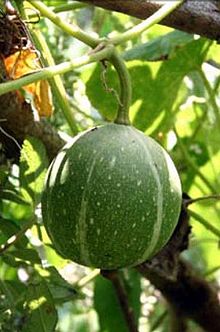| Okeechobee gourd | |
|---|---|

| |
| C. okeechobeensis subsp. okeechobeensis | |
| Scientific classification | |
| Kingdom: | Plantae |
| Clade: | Tracheophytes |
| Clade: | Angiosperms |
| Clade: | Eudicots |
| Clade: | Rosids |
| Order: | Cucurbitales |
| Family: | Cucurbitaceae |
| Genus: | Cucurbita |
| Species: | C. okeechobeensis
|
| Binomial name | |
| Cucurbita okeechobeensis | |
| Synonyms[2] | |
| |
Cucurbita okeechobeensis, the Okeechobee gourd, is a species of gourd in the family Cucurbitaceae, native to Mexico and the United States. There are two subspecies; one is endemic to Florida, primarily in the region around Lake Okeechobee, the other to the State of Veracruz in eastern Mexico.[3][4] Once abundant,[3] it has state and federal listing as an endangered species.[5] One of its peculiarities is the yellow corolla not so common in other Cucurbita species.
A climbing vine, C. okeechobeensis leaves have irregular serrate margins with 5 to 7 angular, shallow lobes. Overall the leaf blades are heart or kidney-shaped. Young leaves are covered with downy hair. The bell-shaped flowers are cream-colored, with long corollas (6 to 7 cm).
The taxonomy of the species and subspecies is uncertain. It was formerly classified as Pepo okeechobeensis.[6]
Some authorities divide it into two subspecies:[7][8]
It was often found growing on abandoned alligator nests in pond apple (Annona glabra) groves near Lake Okeechobee.